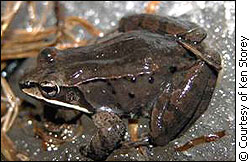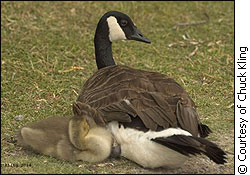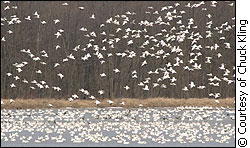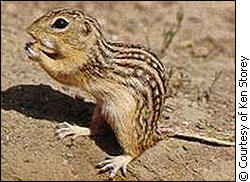
|
|
"This was a 'perfect storm' year," Storey says. "Not only didn't it freeze and not only didn't it snow, but it was warm." Winter woes and wind chills have long been unavoidable inconveniences in the life of a Canadian. But this year, the winter weather was a bit late showing up, leading some to wonder if global warming might be to blame.
This year's slow start to winter was largely due to an El Niño event, says David Bird, a professor of wildlife biology at McGill University. While scientists are debating the connection between climate change and El Niños, this year's warm winter weather gave a sneak peek of what might happen if climate change leads to more warmer winters in the future. Frogs were not the only confused critters this January. Warmer winters can disrupt the natural patterns of many creatures that hibernate and migrate during the season, experts say. Waking in the winter For many animals, this time of year is a chance to slow down their metabolism in order to lower their need for food, says Storey. This helps them survive for long periods of time when the temperature is too cold or there is not enough food available. Animals such as frogs and turtles store up food energy before lowering their metabolism "to be like a car idling very slowly," Storey explains. When the weather warms come spring, they start to rev their engines and prepare to move around, he says. The problem occurs when the winter gets too warm and animals get confused, thinking it is spring, Story says. Some animals, like bats, eat exactly the amount of food they need to last through the winter. When they wake up and start moving around, they waste precious fuel.
"It's like a car that suddenly revs up pointlessly, and uses up its gas," he says. Once an animal has used up this fuel, Story explains, they might not have enough left to make it to spring. Even if an animal stays in hibernation, if it gets too warm around them, their bodies will raise their metabolism and use up their fuel stores, Storey says. If they survive the winter, they might be too weak to search for food in the spring. The temperature difference required to wake a hibernating mammal can be surprisingly small – for some creatures, it only takes an increase of four-degree centigrade. For animals that freeze solidly in the winter, like the wood frogs Storey studies in his lab, one degree can mean the difference between frozen or thawed – life or death. Missed opportunities Non-hibernating animals could also find their lives disrupted by warmer winters. Migrating birds could be in trouble as well. As winter approaches, the days become shorter – signaling to migratory birds that it is time to head elsewhere. However, for those birds that stayed home longer, temperature acts a fine-tuner for migration, David Bird explains. This winter, Canada geese stuck around longer than ever before, he says. Though they normally leave the Ottawa region sometime before Christmas, hundreds remained until mid-January – because they had no reason to leave. "There was no snow cover, so there was still easily-available food," he says, "And there was no ice on the water, so the birds could roost there and be safe at night time from coyotes and foxes."
In general, warmer winters are not a problem for birds, says Bird. However, warmer temperatures, especially in the spring, can throw the timing of migrations off, he says. Bird points to a Scandinavian study from the late 1990s that showed while Great Tits were returning at the same time each spring, warmer weather was causing the caterpillars they eat to hatch earlier. Because migration patterns are tied to food sources, within a few years, the timing was off and birds were returning to discover their food was already gone. "It's sort of like the worst holiday ever," describes Storey. "You get to the hotel and they've given your room to someone else." However, Bird says disruptions in migration patterns are nothing to be concerned about, yet. "Depending on things like El Niño," he says, "it's not necessarily panic time that the birds are all changing their migratory habits." Underwater unease Though under water and out of sight, fish are not immune to the effects of higher temperatures, either. Fish have maximum temperatures they can withstand, explains Thomas Moon, a professor in the Biology department at the University of Ottawa. When temperatures rise beyond these preset levels, fish can go into comas, becoming prey for other underwater creatures. Fish have internal membranes that are critically adjusted to certain temperatures, he says. These membranes have to remain within a set temperature range to maintain a liquid crystalline state, or a degree of fluidity.
If fish are exposed to temperatures to which they cannot adjust, these membranes become leaky and lose ions which causes cell death, says Moon. For fish, this temperature window is critical, he says. Going much beyond it puts the fish in trouble. "Their central nervous system just can't handle it," Moon says. "You know the idea of 'frying your brain'? Well it's true, you can get so hot that your brain just basically fries ... that means you go into a coma and become meat for someone else to eat!" Animals can adapt to changing environments, but it takes generations. "You're talking about genetic changes," Moon says, "and these changes do not occur tomorrow." "When environments change radically, animals do adapt, but it's their offspring that adapt," says Storey. In the mean time, there can be "massive death" among the current population. That is the problem with any global change, says Moon. "Whether it's up or down, if the organism doesn't have adequate time to respond to it and the extremes are too large, then they don't really have much chance." Winners and losers But warmer winters are not bad news for all animals. In fact, many creatures will profit from a balmier season. There are different degrees of hibernation, explains Bird. On one end of the spectrum are animals such as groundhogs that lower their metabolism and hibernate all winter. On the other end are squirrels and raccoons, who sleep for part of the winter but also get up and move around looking for food.
"You might have noticed that the squirrels this year were fat as raccoons," Bird says. This year saw a strong nut crop and plenty of food for squirrels, he says. Combined with warm weather, squirrels were able to move around and just keep eating. Squirrels are the big winners in warm winters. In fact, if this year's warm streak had continued longer, squirrels might have even had the chance to breed twice in one year, boosting the overall population significantly, Bird says. While animals that stay active in the winter profit from the increased availability of food and lack of snow cover, other animals including frogs, turtles, bats and insects that lower their metabolism and hibernate during winter will face tough times if Earth's climate keeps warming. But scientists are not sure what to expect in the future. "This has never happened before in recorded history," Storey says. "This is totally new and scientists have got to admit that they don't know what's going to happen."
Moon explains that it is hard to know what the cause of death might be in animals like fish that have suffered under warmer conditions. "It's not just a heat problem when it comes to temperature, but it's also an oxygen problem because water holds more oxygen at lower temperatures." This means that fish can essentially suffocate in warm water if there is not enough oxygen. Or they could fall victim to toxic algae blooms that are triggered by higher temperatures, Moon explains. "When you see a dead fish, all you know is that it's dead, right?" he says. But figuring out just how it died is no easy task. The consequences of higher temperatures and warmer winters are unknown, Storey says. But there is no denying that Earth's climate is changing. "Global warming is like an ocean liner. Sure you can stop it by turning off the engines, but then it goes for miles and miles until it runs into something because it's already got momentum," Storey says. "Even if we stopped all emissions right now, the Earth would still warm further." With the global climate changing at an accelerated rate, many hibernating and migrating animals may soon have to re-consider their winter plans in order to keep up with their changing environments. [Thumbnail photo courtesy of Chuck Kling]
|
|
|



